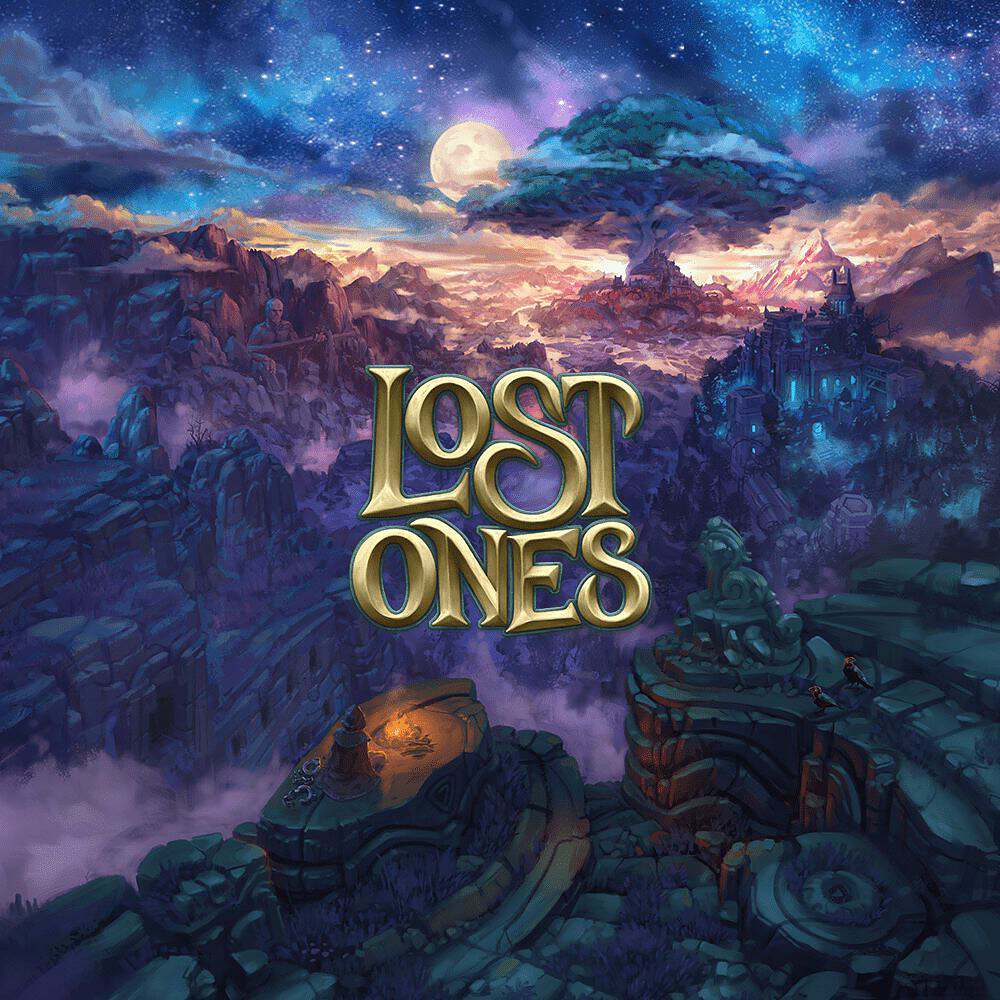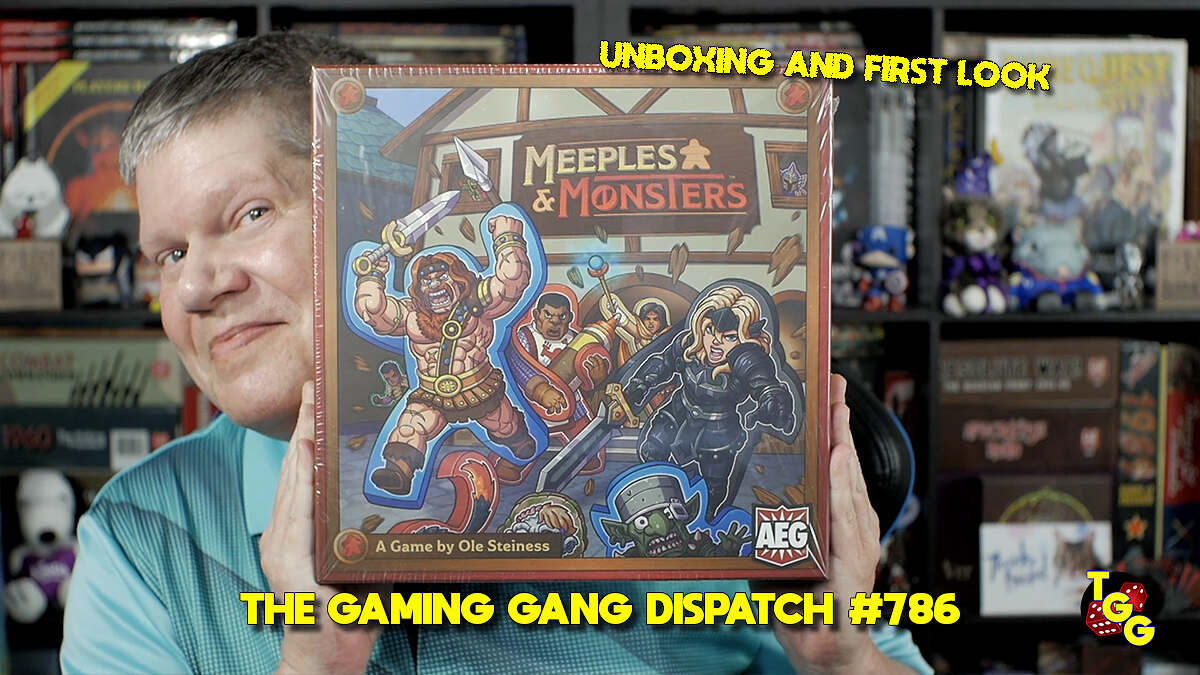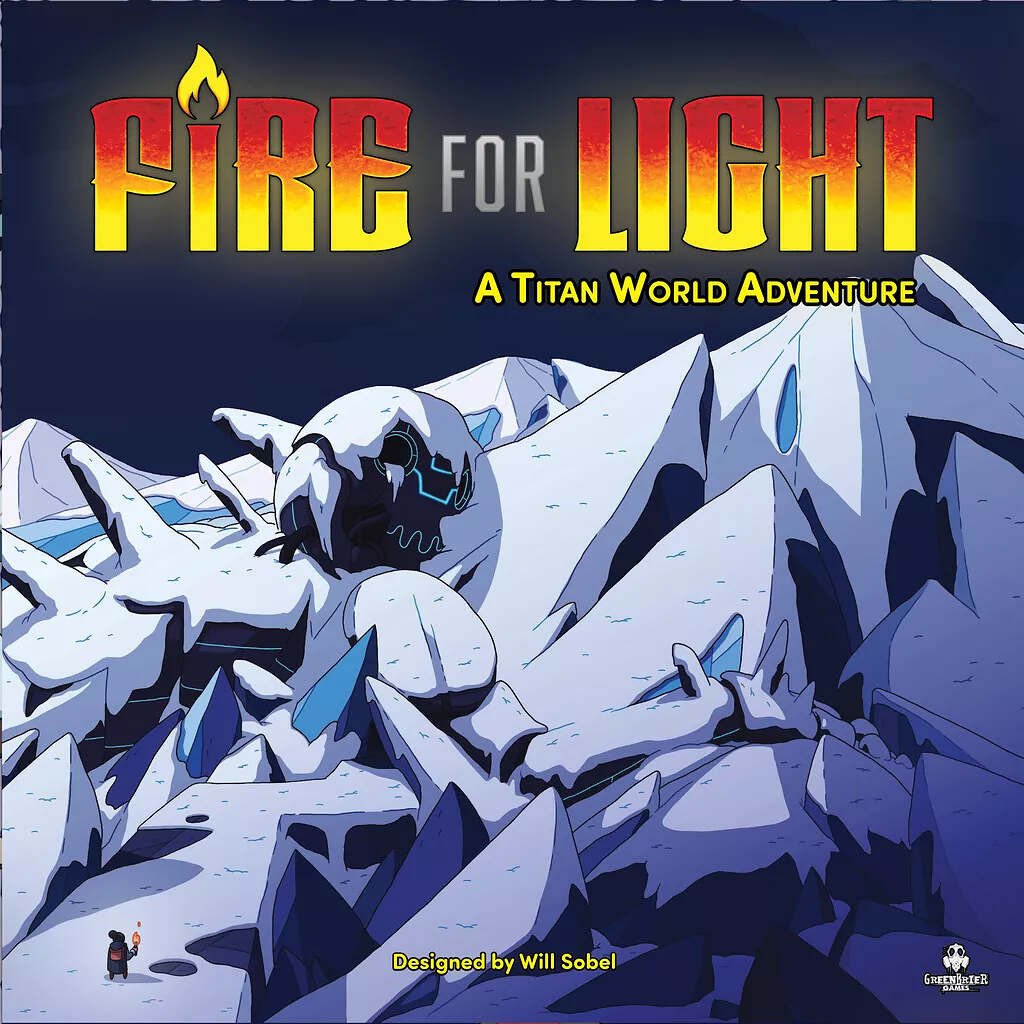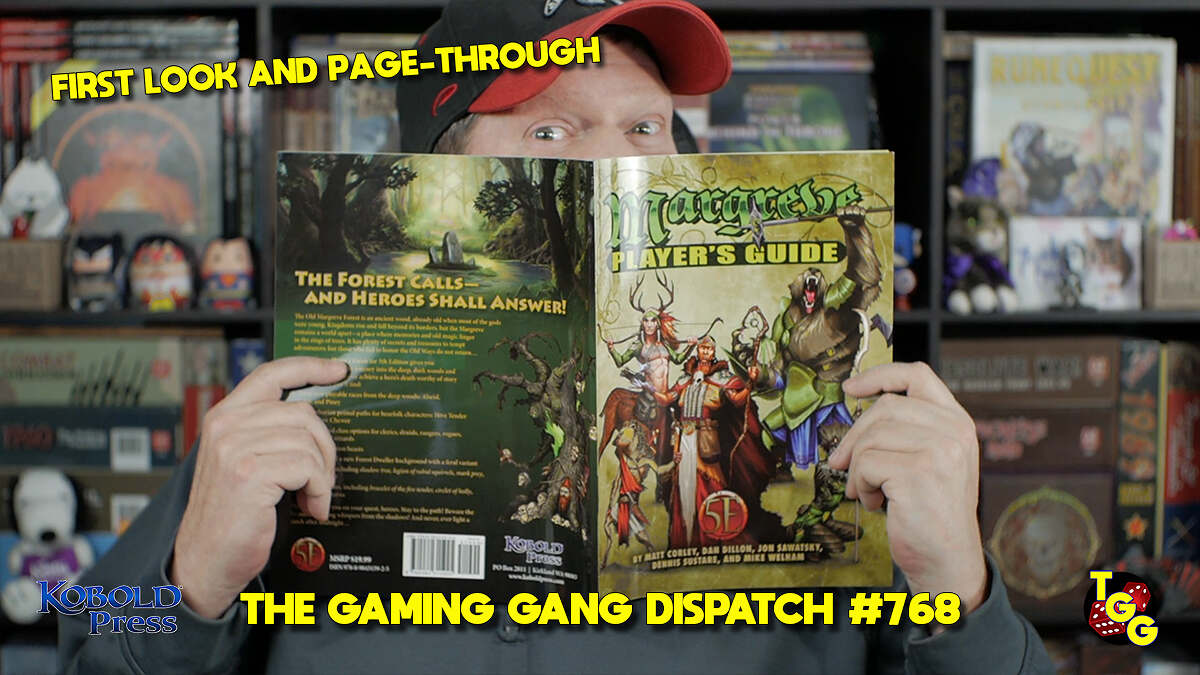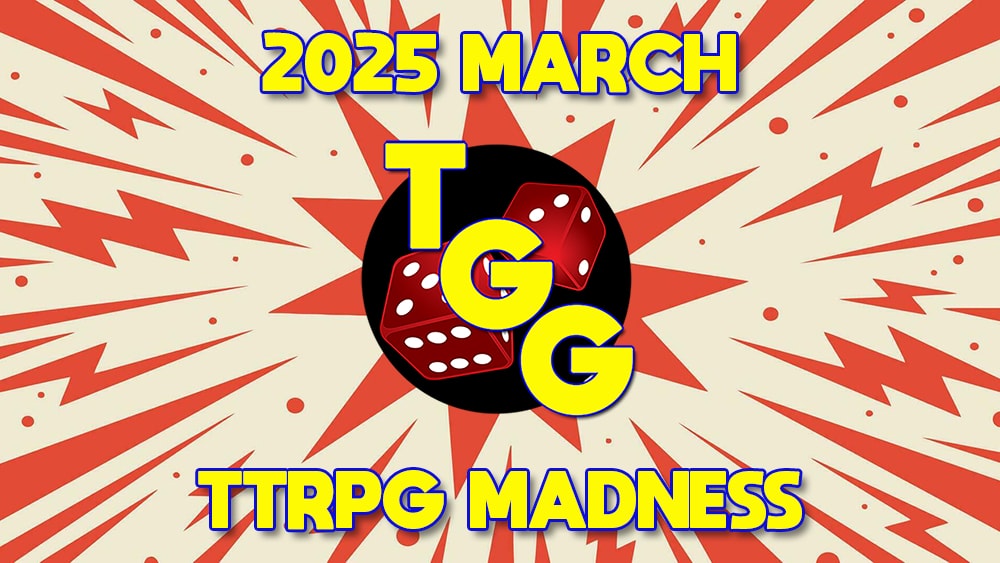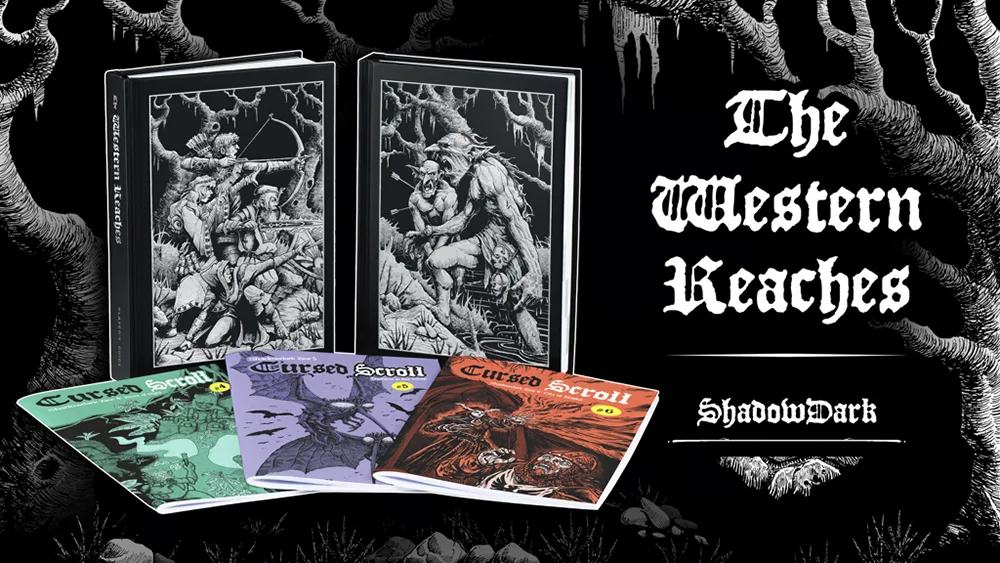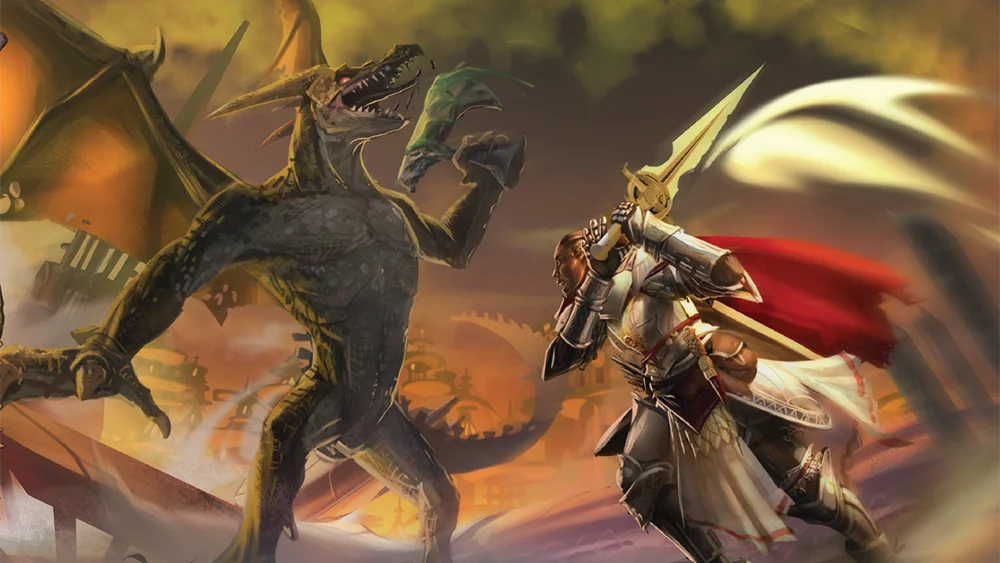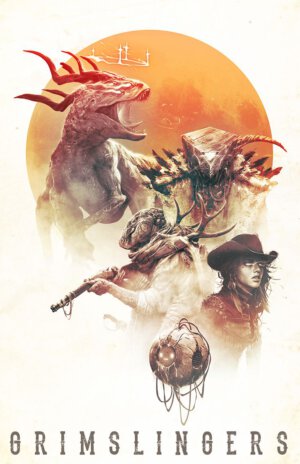
Publisher: Greenbrier Games
Designer: Stephen S. Gibson
Artist: Stephen S. Gibson
Year: 2016
Players: One to six players
Ages: 14+ (More likely eleven or twelve in my opinion)
Playing Time: 15 – 90 minutes
Genre: Card driven dueling game in a weird west/SF setting
Retail Price: $19.95
Components:
- 280 Cards
- 1 Rulebook
- 1 Tall Tale: Valley of Death
- 1 Meeple
- 1 six sided die
- 1 Valley of Death map
Outside the Box: Grimslingers
Here’s how Greenbrier lays out the weird west/SF setting…
“In a land beyond God’s reckonin’ is a place called the Forgotten West. A cursed land of sorts in the American frontier, housing the damned, the mysterious, the unfortunate. You ended up there, God knows why, and you sure ain’t leavin’ anytime soon.
“The Iron Witch, a downright mysterious bein’, has turned you into a Grimslinger, a powerful witch imbued with metal, machine and fancy elemental powers. Now yer maker’s requirin’ all his newly sired to duel each other so that he can make y’all into witches proper for his own purposes.”
The first thing which will obviously catch one’s eye about Grimslingers is the phenomenal artwork provided by Stephen S. Gibson. I’m even guessing quite a few gamers will pick up the release on the strength of the artwork alone. Gibson also happens to be the game’s designer and it’s interesting to see someone pulling off that sort of rare double duty. Grimslingers actually began life as a proposed mobile app and this is readily apparent in the head to head dueling or what I would consider the “basic” game.
For two players just learning the game, each will chose a Grimslinger character (special abilities aren’t used in the basic game), an Anima (strange, mechanical sidekicks which all have the same abilities), Health and Energy trackers (one of each), and a set of the six elemental spell cards. There’s also a ten card number deck (two of each card, numbered one through five) which you’ll shuffle and place to the side for when you enter into a Face-Off. Players will begin the game by placing their Grimslinger on the Health Tracker and the Anima card on the energy tracker with both indicating ten of each resource.
Grimslingers proceeds in turns which are further broken down into phases.
The Standoff – Each player may then choose to 1) sacrifice one Health for one Energy or 2) use their Anima’s purge, reload, or surge ability. The more advanced game brings more options into play such as gaining items, using items, trading with teammates, or even using a Grimslinger’s special ability.
The Draw – Now each player will select a spell card from their hand and place it face down. With advanced rules players may use an applicable item instead of a spell. Once everyone has placed their card/cards face down someone calls out “Draw!” and the cards are revealed simultaneously. A player can jump in before the cards are revealed to decide to pass. If anyone passes that player’s cards are returned to their hand and they gain two Energy.
The Aftermath – This phase actually begins with a bit of housekeeping as players will return deactivated cards from the previous turn to their hands. There is a difference between discarded cards and deactivated cards and it’s important to keep these separate in the player’s area.
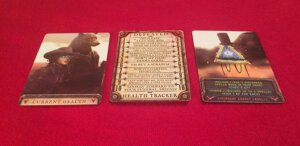
If the spells are essentially neutral to each other then a mini-game, known as the Face-Off, begins in order to resolve what happens next. The Face-Off is a bit like blackjack but players look to get closest to eleven (as opposed to twenty-one) without busting. Players take turns drawing cards until one chooses to hold or they bust. The player closest to eleven wins and their spell deals any FX while the loser discards their spell. If the loser also busted then they take double damage as well. If both hold, and there’s a tie, both spells are discarded and nothing happens.
Turns are repeated until only one player remains with at least one point of Health at which that point they’re declared the winner.
Advanced rules change up to proceedings quite a bit with the addition of twenty-four signature spells players can choose from to add to their repertoire, items, spell resolution timing, and archtypes to give each Grimslinger a unique flavor and ability. The additions do add some complexity to the game but also perform wonders for the replayability of the overall design. Once new players get accustomed to the basics, I highly recommend graduating to this more robust game style.
There’s also the Tall Tale game mode in which up to four players cooperatively play through a campaign in the Forgotten West. The characters can even gain experience and level up throughout the adventure to add new items and spells to their inventories as the players become more powerful. The Valley of Death is the tale included in the base game a provides a bit of a “create your own adventure” vibe to the proceedings as the group travels across the map by winning duels against NPCs and monsters to advance the story. You can even play Valley of Death solo.
Now that you have a good idea of how Grimslingers plays let me share some thoughts about the game itself and *sigh* I’ll begin with the negatives.
Although the game does indicate you can play with as many as six players, I have to disagree with that assessment and say the cutoff should really only be four players. You want to keep in mind a lot of the fun with the duels is trying to not only figure out what your opponent is going to sling your way but also aiming to outfox them with your own spells. While I wouldn’t consider Grimslingers a true bluffing game you’re still going to want to mislead your opponent at every opportunity.
As an example, let’s say I’m down to four health and that’s a bit too close to losing for comfort. If I can successfully cast the earth spell then I’ll gain two health back. Yet, if my opponent casts the water spell, which beats earth, I’ll be out of luck and lose two more health and get nothing from my spell. I can see if water has been discarded (but not deactivated as those are placed face down) or not so if I believe my opponent still has water in their hand I’m probably not going to want to cast earth. Then again, sometimes it might be in your best interest to play the obvious spell and let the enemy overthink the situation thus watching them play a card which won’t automatically beat yours or, better yet, blunders into your spell which just happened to beat theirs. This back and forth provides a nice level of tension and trickery to the duels.
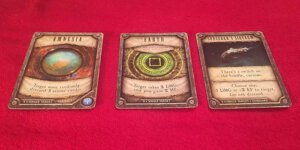
Next on my mini gripe list isn’t a full blown negative but worth mentioning none the less. While the Tall Tale mode is loads of fun, as well as a good challenge, most folks are really only going to play through once or twice. After your gaming gang has completed the adventure there really isn’t much call to repeat it again. Granted, if you have a revolving group of people you gather around the table with you’ll get more mileage out of the campaign but for most gamers I’d say one or two run throughs are about it. Still, I’m looking forward to more Tall Tales for Grimslingers, that’s for sure!
My final negative is something which unfortunately plagues a few Greenbrier releases. Let me say I happen to like everything I’ve run across from Greenbrier Games. I also have to say my experiences talking with Jeff and Theresa Garcia have always been great and Julie Ahern, who contributes most of the setting fiction and such for the company, is one of the coolest people you’ll meet in the industry and a great interview. Having said this Greenbrier really, really, REALLY needs to hire an experienced professional who understands rules presentation. I’m serious and bet I’m not the only one who dings the company from time to time with this.
In this case the rules for Grimslingers read as if the designer wrote the final draft of the rules. Trust me folks, this is not normally a good thing as designers are great at making games but usually atrocious at teaching a complete stranger how to play them. This is where a developer comes in as they tend to flesh out the game design while also working on presenting the rules in (hopefully) an easily understood format. Grimslingers’ rules suffer because everything is presented as if the reader is thoroughly digesting the box contents all at once and it doesn’t help that there are no examples of play. I had to turn to Stephen Gibson’s tutorial vids online and even he made some mistakes about the rules.
One example of this lack of clarity is the explanation of card discards. The rules display what each player’s area should look like and where cards are either discarded or deactivated; spells are discarded once cast while cards are usually deactivated (removed from your hand) due to spell FX. Yet nowhere in the rules is it clearly explained, in black and white, how those discards are returned to your hand. Since there aren’t any examples of play, the reader is left scratching their head until they happen to look at one of the Anima cards and find the reload ability. It turns out you can spend three Energy during the standoff phase to return four discards to your hand. Learning the abilities of the Anima also unlocks an understanding of what the point of having an Energy Tracker even is in the first place.
I’m certainly not going to rail against Greenbrier as if they’re the only company producing games which demand extra digging through rule books or force you to go online in order to learn how to play; there’s been a disturbing trend the past few years as many companies are becoming very lazy in their playtesting and rules presentation. Sure, it isn’t too hard to jump online to read an FAQ or watch a tutorial but it shouldn’t be a prerequisite which gamers go through just to bring a newly purchased title to the table.
Companies need to stop assuming people should go online to learn their games. If that were the case, why include a rule book in the first place? Plus, I happen to be old school in a lot of ways and one of those ways is thinking the rule book should teach you a game; when I got into the hobby our only option was the rules – and only the rules – if you wanted to find out how to play as there were no laptops, tablets, phones, or even a low speed internet available to assist you.
Don’t get me wrong. Grimslingers rule book isn’t completely horrible and incomprehensible. The previous two paragraphs are more about a negative trend in the hobby rather than precisely how Grimslingers is presented or that Greenbrier produces exceptionall cryptic rule books. Still, I say Greenbrier needs to get a better handle on how the company lays things out in order to learn some of their titles.
Of course, by this point you probably think I don’t like Grimslingers. The truth is there’s a hell of a lot more positive than negative going for the game once you have a grasp on play.
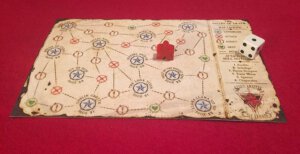
I found the setting of the Forgotten West to be really interesting too. Stephen Gibson has obviously invested a lot of imagination into this weird – and a touch wacky – western/SF mashup and if Greenbrier ever considers entering the RPG arena they certainly have a good starting point with Gibson’s vision. I will point out you have to take on the Tall Tale in order to actually delve much into the world background to any extent but Valley of Death is a cool adventure.
Finally, I have to tip my cap to Greenbrier for packing so much gameplay into a $30 game. I know a good number of companies would have included just the components for the six player basic game of Grimslingers and rolled it out to the masses at the same $30 price point or higher. I’m happy to say you get the basic game, all the goodies for advanced play, as well as the co-op Tall Tale jam packed into a fairly small footprint box.
While Grimslingers has a few problems (mainly in the rules presentation department) don’t let those small bumps in the road dissuade you from picking up the game. Most gamers are going to find the basic dueling provides one of the better takes on the rock, paper, scissors mechanic on the market and the addition of advanced rules insures plenty of variety whenever you play. It’s also loads of fun to move on from beating up on your friends and join up to cooperatively try to survive the Valley of Death.
[rwp-review id=”0″]
- Pre-order the Warhammer 40,000 Roleplay: Imperium Maledictum – Macharian Requisition Guide - Mar 14, 2025
- Gary Gygax’s Castle Zagyg Volumes #1-3 is Up for Crowdfunding for Troll Lord Games - Mar 14, 2025
- Blacklight Modern Horror Shadowdark Fueled RPG Passes 300% Funding on Kickstarter - Mar 14, 2025



